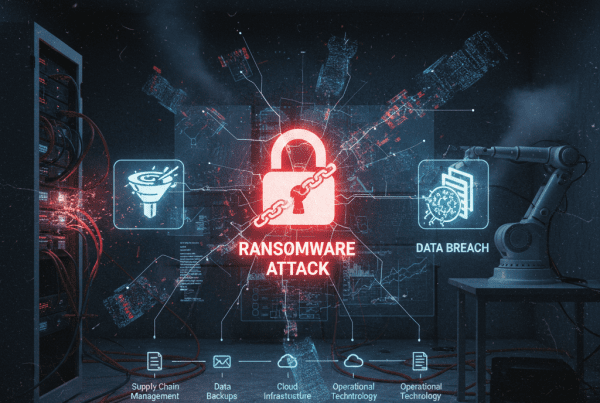Regulated industries do not just face cyber threats. They also carry the pressure of proving they are prepared to handle them. In sectors like healthcare, finance, legal, and government, the burden of compliance is both technical and procedural.
As technology environments grow more complex and regulatory expectations continue to shift, maintaining compliance has become more difficult. Clients and regulators are asking tougher questions, expecting clearer answers, and holding organizations accountable for risks across their entire supply chain.
This post outlines what it takes to keep your cybersecurity efforts aligned with changing regulations, growing threats, and the increasing demands of today’s connected business environment.
What Cybersecurity Compliance Means for Regulated Industries
Cybersecurity compliance refers to the act of meeting specific security requirements set by laws, industry standards, and government regulations. Unlike general cybersecurity best practices, compliance involves aligning your policies and systems with a defined framework. In regulated industries, these frameworks are not optional. They are enforced through audits, reporting, and penalties for violations.
Some of the most common compliance frameworks include:
- HIPAA for protecting patient health information in healthcare settings
- PCI DSS for securing credit card data in financial services and retail
- SOX for financial transparency in public companies
- GDPR and CCPA for safeguarding personal data in the European Union and California
- SOC 2 for ensuring service providers meet security, availability, and confidentiality standards
Each regulation has its own requirements, but most focus on a few core areas. These include data encryption, user access controls, activity logging, regular security audits, and breach response protocols. Compliance is an ongoing effort that involves people, processes, and technology working together.

Common Compliance Challenges and Risks
Even organizations that prioritize cybersecurity can fall short when it comes to compliance. The issue is often not a lack of awareness; it’s the difficulty of putting the right processes into practice. Below are some of the most common compliance risks facing regulated industries.
- Outdated Technology: Legacy systems often lack the security features needed to meet modern compliance requirements. They may be missing encryption capabilities or have unpatched vulnerabilities that create risks.
- Limited Visibility and Monitoring: You can’t secure what you can’t see. Many organizations don’t have proper logging or monitoring systems to detect unauthorized access or data movement. Without visibility, it’s impossible to meet many audit and reporting requirements.
- Weak Access Controls: Employees often have access to more data than necessary for their roles. Without role-based access control or multifactor authentication, your data is vulnerable to both internal misuse and external attacks.
- Insufficient Training: A large percentage of data breaches involve human error. Phishing attacks, weak passwords, and mishandling of sensitive data can all be prevented with better training and internal awareness.
- Incomplete Policies and Documentation: Auditors want proof that your organization is following security policies consistently. If your policies are outdated, undocumented, or not being followed, it will create problems during an audit.
Five Core Strategies to Stay Cybersecurity Compliant
Staying compliant takes a focused, organized approach. These five strategies are the foundation for meeting your regulatory obligations and reducing your risk exposure.
- Know Your Requirements: Before you can build a cybersecurity compliance plan, you need to know which laws, regulations, and standards apply to your organization. These vary depending on the type of data you handle and the industry you are in. For example, a healthcare provider must comply with HIPAA, while a financial institution may need to follow PCI DSS or SOX. A government contractor might fall under frameworks like NIST 800-171. If your organization operates in more than one industry or serves clients in different regions, you may need to follow several frameworks at the same time. It is important to identify those requirements early so that your security policies and systems are designed to meet them.
- Conduct Regular Risk Assessments: A risk assessment is a detailed review of your current cybersecurity posture. It identifies potential vulnerabilities, evaluates the likelihood and impact of different threats, and offers recommendations for improvement. Most compliance frameworks require some form of periodic risk assessment. It is best to bring in an outside expert for this process. A third-party risk assessment provides objectivity and helps you discover gaps that internal teams may overlook. The results can guide your investments, policies, and security upgrades.
- Control Access and User Privileges: Not everyone needs access to all systems or data. Compliance frameworks generally require that access be granted on a need-to-know basis. This reduces the chance of insider threats, accidental exposure, or stolen credentials causing major damage. Make sure your user accounts are tied to specific roles. Use multifactor authentication wherever possible. Review and remove access regularly, especially when employees change roles or leave the company. Automation tools can help you manage user access in a way that is consistent, accurate, and easy to track, which is especially important for meeting compliance standards.
- Make Training Part of the Culture: Cybersecurity training is one of the most overlooked but powerful tools for compliance. All it takes is one employee clicking a phishing link or sharing credentials to trigger a breach. Build a culture where security is everyone’s responsibility. Train staff regularly on the latest threats, your company’s policies, and their role in protecting sensitive data. Make training interactive and relevant to different departments. Employees are more likely to follow security practices when they understand the why behind them.
- Work With Compliant Vendors: Compliance is a shared responsibility. If you outsource IT, cloud services, or data processing, you need to be confident your vendors are meeting their own security and compliance obligations. Their gaps can quickly become your liability. Look for partners whose certifications align with your regulatory requirements. For example, a vendor that is SOC 2 Type 2 certified, like Atlantic, Tomorrow’s Office, has demonstrated that its internal systems meet rigorous standards for security, availability, and confidentiality. That kind of third-party validation is especially valuable when sensitive data is involved. It also shows a continued commitment to upholding strong security practices that support your compliance goals.

Compliance Should Be Built into the Workflow
One of the biggest mistakes businesses make is treating compliance as something they revisit only during audits or annual reviews. That approach often means checking policies off a list once a year and assuming the work is done. But regulations change. Technology shifts. New threats emerge. If your compliance strategy is not reviewed and adjusted regularly, it becomes outdated, and that creates risk.
Compliance needs to be part of your day-to-day workflow. This means embedding secure processes into how your team operates. It also means setting up systems that provide ongoing visibility, monitoring, and reporting. These systems allow you to catch and fix problems early, rather than waiting for an audit to reveal them.
When you build compliance into the way you work, it becomes easier to maintain. You also reduce the stress of preparing for audits, security questionnaires, and customer inquiries.
Choosing the Right Technology and Partners
Good cybersecurity tools can help streamline the entire process. Look for solutions that include the following features:
- Activity logging and audit trails
- Role-based access control
- Encryption of data in transit and at rest
- Automated patch management
- Real-time threat detection and alerts
- Reporting tools that map to compliance standards
Technology alone is not enough. You also need the right people and partners. Managed IT providers, cloud vendors, and software providers should all be held to high compliance standards. Ask to see their certifications. Understand how they protect your data. Make sure they can support your audits or regulatory inquiries when needed.
Working with vendors who have already been certified or assessed can save your team time and help demonstrate due diligence to auditors.

Making Cybersecurity Compliance Sustainable
Cybersecurity compliance is about responsibility. If your organization handles personal information, health records, financial data, or legal documentation, you are expected to protect it. Regulations are the structure that supports that expectation. And compliance is how you prove that your systems and processes are up to the task.
The good news is that staying compliant is not out of reach. By understanding the requirements, assessing your risks, tightening your access controls, training your staff, and working with reliable partners, you can protect your business and meet the expectations of your industry.
Cybersecurity compliance does not need to be a burden. With the right approach, it becomes part of how you operate — confidently, securely, and professionally.
About Atlantic, Tomorrow’s Office
Atlantic is an award-winning office technology and IT solutions company providing Imaging Products, IT Support, Document Management, Cybersecurity and Managed Services to small and large companies in the New York City metropolitan area, and the Greater Philadelphia and Delaware Valley.For the latest industry trends and technology insights visit ATO’s main Blog page.




